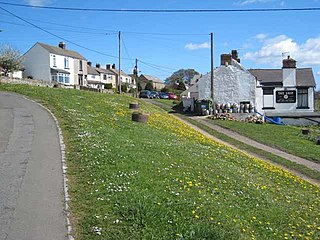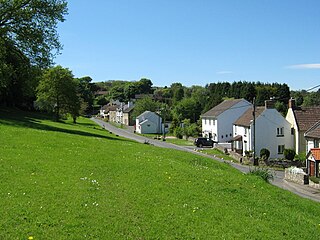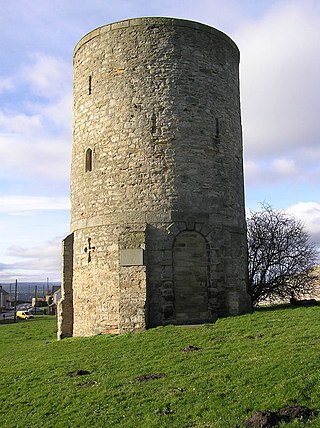
Willington is a town and former civil parish, now in the parish of Greater Willington, in the County Durham district, in the ceremonial county of Durham, England, in the foothills of the Pennines and near the River Wear close to Crook, Bishop Auckland and Durham.

Newton Aycliffe is a town in County Durham, England. Founded in 1947 under the New Towns Act of 1946, the town is 5 miles to the north of Darlington and 10 miles to the south of Durham. It is the oldest new town in the north of England. Together with the bordering Aycliffe Village and the north part of School Aycliffe, it forms the civil parish of Great Aycliffe. The population of the town at the time of the 2011 census was 26,633.

Cassop is a village and former civil parish, now in the parish of Cassop-cum-Quarrington, in the County Durham district, in the ceremonial county of Durham, England. It has a population of about 500 and is located near the city of Durham. A former mining village, mining is no longer the main occupation of Cassop's inhabitants due to extensive mine closure over the last 30 years.

Byers Green is a village in County Durham, in England. It is situated to the north of Bishop Auckland, between Willington and Spennymoor, and a short distance from the River Wear.

Plawsworth is a village and former civil parish, now in the parish of Kimblesworth and Plawsworth, in the County Durham district, in the ceremonial county of Durham, England. It is situated a short distance to the east of Sacriston, on the A167 between Durham and Chester-le-Street. In 1961 the parish had a population of 1570.
Mainsforth is a small village and former civil parish, now in the parish of Bishop Middleham, in the County Durham district, in the ceremonial county of Durham, England. It is to the east of Ferryhill. The earliest settlement in Mainsforth may have been on Marble. It has been suggested, without great historical foundation, that this was a Danish settlement. In 1961 the parish had a population of 229.

Cowpen Bewley is a village and former civil parish, now in the parish of Billingham, in the Stockton-on-Tees district, in the ceremonial county of Durham, England. In 1931 the parish had a population of 706.

Newfield is a village and former civil parish in the County Durham district, in the ceremonial county of Durham, England. It is situated to the south of Willington, near Bishop Auckland. In the 2001 census Newfield had a population of 368.
Heighington is a village in the borough of Darlington and ceremonial county of County Durham, England. The population of the civil parish at the 2011 census was 2,395. It is situated between Darlington and Shildon, near Newton Aycliffe. One of its most significant features is St Michael's Church that sits in the middle of a large village green. The church is Norman, except for the 13th-century south aisle and the 19th-century north aisle. A rare feature in this church is a pre-Reformation oak pulpit with six traceried linen fold panels, with an inscription bearing prayers for its donor: an Alexander Flettcher and his wife Agnes.

Helmington Row is a small village and former civil parish, now in the unparished area of Crook, in the County Durham district, in the ceremonial county of Durham, England. It is situated between Crook and Willington. About 7 miles South West of Durham and 3 miles north, north west of Bishop Auckland.

Embleton is a hamlet and former civil parish, now in the parish of Sedgefield, in the County Durham district, in the ceremonial county of Durham, in England, as well as the site of a medieval village and manor. It is situated 3 miles (5 km) east of Sedgefield and 4 miles (6 km) west of Hartlepool. In 1961 the parish had a population of 80. The township was historically named "Elmdene", supposedly derived from the site's proximity to a woodland of elm trees which, at an earlier time, flourished in the bordering dene. A single farmstead now occupies the site which lies adjacent to the ruins of a small church dedicated to the Virgin Mary.

Middlestone is a village and former civil parish in the County Durham district, in the ceremonial county of Durham, England. It is situated to the south of Spennymoor, near Kirk Merrington. In the 2001 census Middlestone had a population of 67.

Redworth is a village and former civil parish, now in the parish of Heighington in the borough of Darlington and the ceremonial county of Durham, England. It is west of Newton Aycliffe, between Darlington and Shildon. It had 190 residents at the time of the census in 2001. The name Redworth originates from the words Reed Worth, as the area was a large marsh. Redworth is home to Barcelo Redworth Hall, a 4 star hotel, which has been visited by many famous figures, including the England football team. Redworth Wood is filled with protected trees, and even a Stone Age fort, which has been pictured in the Northern Echo.

Whitton is a village and former civil parish, now in the parish of Stillington and Whitton, the borough of Stockton-on-Tees and the ceremonial county of Durham, England. It is situated to the north west of Stockton-on-Tees, near Stillington and Thorpe Thewles.

Sedgefield is a constituency in County Durham represented in the House of Commons of the UK Parliament since 2019 by Paul Howell of the Conservative Party. It elects one Member of Parliament (MP) by the first past the post system of election.

Borough of Darlington, or Darlington borough, is a unitary authority area in County Durham, Northern England. It is named after the town of Darlington and in the Tees Valley mayoral area. The area borders three local authority areas; the County Durham district is to the north and west, Stockton-on-Tees to the east and North Yorkshire to the south, the River Tees forming the border for the latter. In 2011, the borough had a population of 106,000. The council is Labour / Liberal Democrat.

Stillington is a village and former civil parish, now in the parish of Stillington and Whitton, in the Stockton-on-Tees district, in the ceremonial county of Durham, England, northwest of Stockton-on-Tees.

Chopwell is a village and former civil parish, now in the unparished area of Blaydon, in the Gateshead district, in the county of Tyne and Wear, England, 3 miles (4.8 km) west of Rowlands Gill and 1 mile (1.6 km) north of Hamsterley. At the 2011 Census, it had a population of 9,395.

Westerton is a village and former civil parish in the County Durham district, in the ceremonial county of Durham, England. In the 2001 census Westerton had a population of 44. It is situated between Bishop Auckland and Spennymoor. It sits on top of a hill which is one of the highest points in County Durham, and is the location of an observatory built for Thomas Wright, who was the first person to suggest that the Milky Way consisted of a flattened disk of stars. The observatory is known today as "Wright's Folly".


















